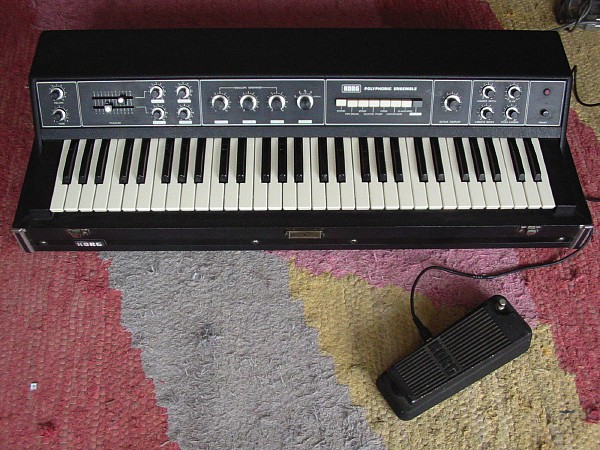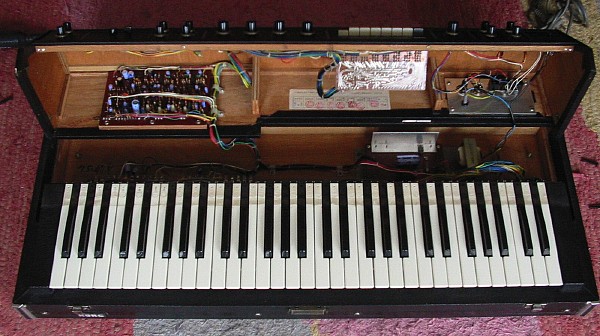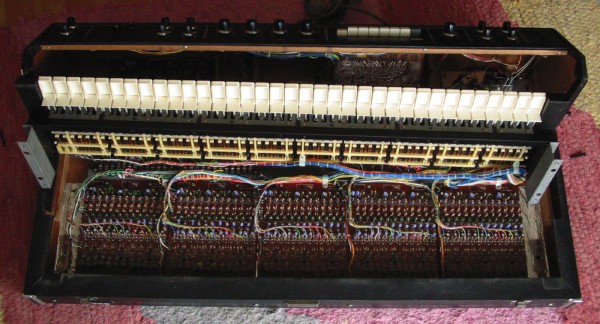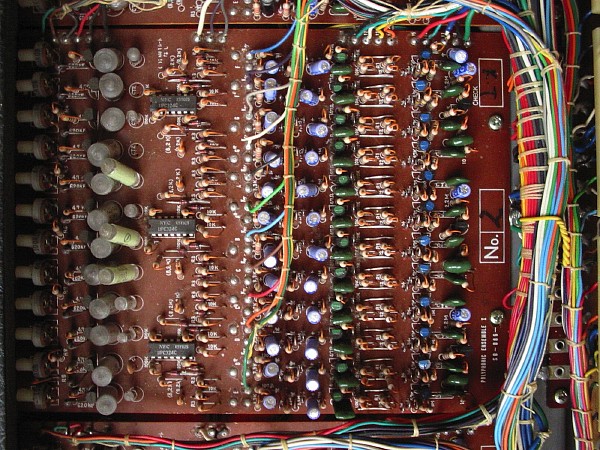Korg Polyphonic Ensemble 1000 

Often also named Poly Ensemble or K-4 was build from 1976 to 1979/80 it is often mistaken as being little brother version of the Korg PE-2000. But this is not like this! The parameters available, the technic inside and of cause the sound are very different
Its main feature compared to nowadays keyboards is its full polyphonic structure. That is, each and every key will make a sound at the same time (if needed). No voice stealing on long release time notes.
It is build like so many keyboards of this time in a suitcase like box with a detachable lid. Nice for live gigs. In this case with red velvet inside cover you find two very hand build in garages. One for the non detachable power cord, the other for the included pedal and the DIN cable to connecting the pedal to the instrument. This pedal changes the brightness of the sound. It maybe bypassed to the set panel setting by the foot switch on the pedal.
It got the following sections on the pront panel:
- Master
- Master volume
- Instrument tune
- Filter (not per key but as master "FX" changing the overall sound)
- 2 Traveller filter sliders (as seen on so many vintage Korg synths)
- Peak H (highpass filter resonsonance)
- Peak L (highpass filter resonsonance)
- Soft (adjusting the sound colour)
- Expand (adjusting the envelope modulation to the filter)
- Evelope and Waveshape
- Attack (with an off-switch in fully counter-clockwise position)
- Decay
- Sustain (acting as release)
- Waveshape selector rotary switch named "Mode":
- narrow pulsewave
- pulsewave
- squarewave
- sawtoothwave
- chorus wave
- Preset Selction
- String
- Pipe Organ
- Brass
- Piano
- Electric Piano
- Harpsichord
- Clavichord
- Control (sets the controlls of the Envelope and "Mode" switch to active)
- Octave Coupler
- big knob to mix in a copy of the sound one octave below. Will give a detuning of two oscillators depending on the "Pitch Expand" knob in the next section.
- Pitch
- Vibrato Depth (obvious)
- Vibrato Speed (obvious)
- Glide (actully adds an upward or downward pitchbending. The 12 o'clock setting is no pitch bending.
- Pitch Expands (changes the tunning linearity, so that the pitch on the higher keyboard end is a bit to too much to high, and the lower endof the keyboard to low. Together with the Octave Coupler this is were you get the ensemble sound from.

Undo the 2 screws on each side of the panel and you can have a peek inside
The traveller filter is the one on the left. The preset switch with it preset controll voltages is in the middle. The metal board on the right is the back of the sockets and the mains in cable. And finally the power transformer in in the bottom to the right

And if you remove the 4 screws on the bottom, you can then lift up the keyboard action to see the 5 voiceboards inside. Each voiceboard for one octave of keys.

The 5 voiceboards contain an oscillator per key. It got an labeled trimmers (on the left) to adjust the pitch of each key. Each of the twelve notes of a scale got here a single filter and VCA. The parts of the filter and the wave shape former are varying for each key. The little chip appears to be an µPC324C (low power quad operational amplifier).
Compared to the tripple top-octave voice generation of the Korg PE2000 (Poly Ensemble S), this is technically very differnt !
Sound example
Have a listen:
[download here] (10.1 MB, 5:32 of mono mp3 256 kb/sec)
Sound used in the order you hear them:
- Control 0:00
- Strings 2:26
- Pipe Organ (well ...) 3:08
- Brass 3:38
- Electric Piano 4:04
- Piano 4:26
- Harpsicord 5:01
- Clavicord 5:13